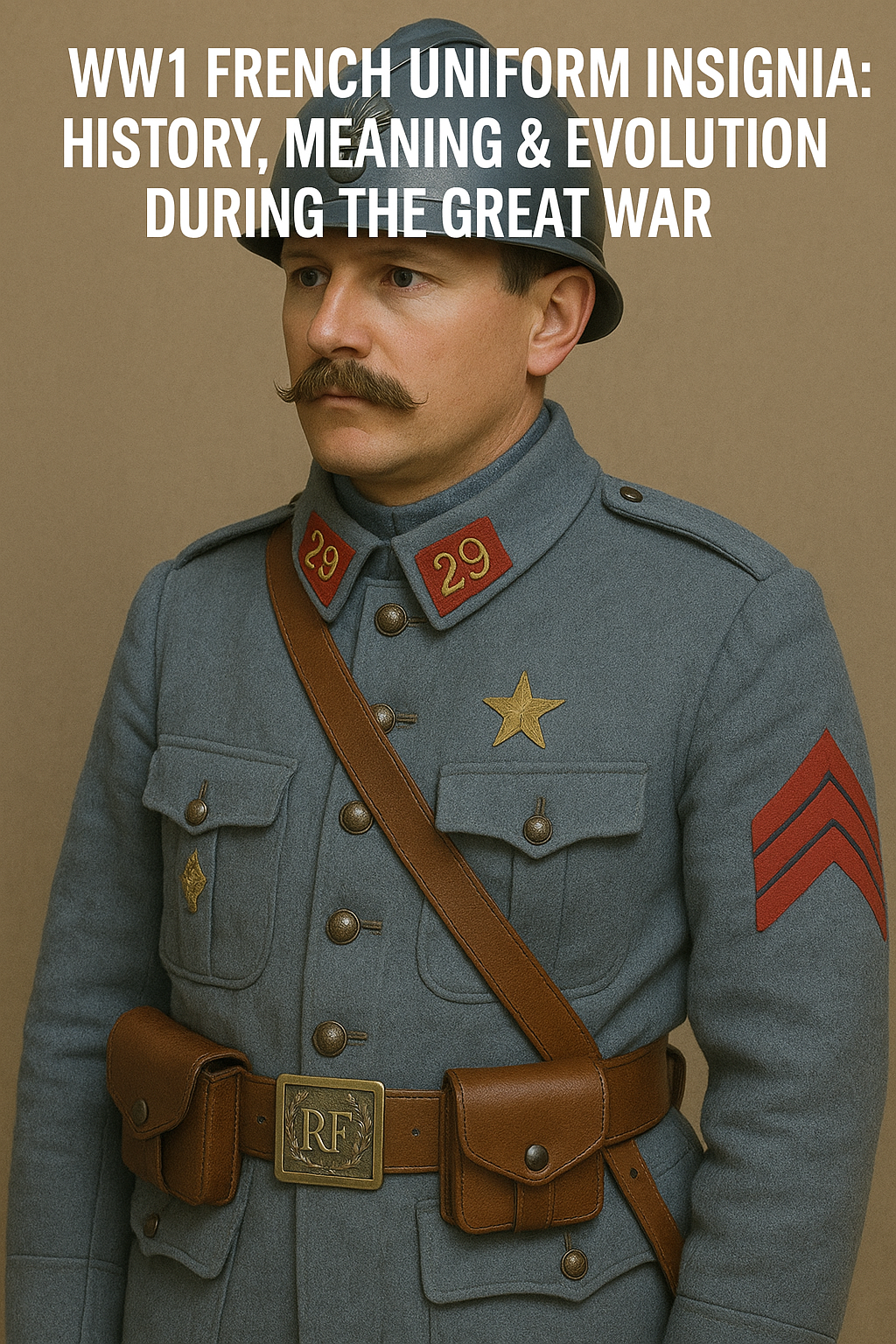
WW1 French Uniform Insignia: History, Meaning & Evolution During the Great War
Published on Apr 30, 2025
WW1 French Uniform Insignia: A Symbol of Rank, Honor, and Sacrifice
When we think of World War I, images of muddy trenches, barbed wire, and the thunder of artillery often come to mind. But there’s another layer to the war—one woven into the very fabric of the uniforms worn by the soldiers. Among the most symbolic aspects of military attire were the insignia, carefully stitched or pinned to the uniforms to represent rank, regiment, and national pride.
For French soldiers, these insignia were far more than mere decoration. They were badges of identity, order, and honour, especially critical in the chaos of WWI. Let’s delve into the fascinating world ofWW1 French uniform insignia, their history, and how they remain symbols of a nation that endured immense loss during the Great War.
A Brief Overview: France in World War I
Before exploring the insignia themselves, it’s essential to understand the context in which they were used.
France was one of the principal Allied Powers during World War I, suffering staggering human and economic losses. With approximately 1.4 million military deaths, France bore one of the heaviest burdens of the war. According to the pillar page on French deaths in WW1, entire regions were depopulated, and the scars of war are still visible today in the form of cemeteries, memorials, and historical battlefields.
In such a vast military force—made up of career soldiers, draftees, and even foreign volunteers—uniform insignia were necessary for maintaining structure and communication on the battlefield.
What Were WW1 French Uniform Insignia?
Uniform insignia refer to the visual markers worn on military uniforms to signify:
- Rank (officer, NCO, enlisted)
- Branch of service (infantry, cavalry, artillery)
- Regiment or unit
- Special qualifications or duties
- National identity (particularly for foreign volunteers)
The French military during WWI had a detailed and organized insignia system to help differentiate soldiers in a rapidly expanding army.
Types of WW1 French Uniform Insignia
1. Rank Insignia
French ranks during WW1 were displayed mainly through chevrons, stars, and shoulder straps.
- Enlisted men and NCOs wore horizontal chevrons on their sleeves, with variations in colour and placement depending on the rank.
- Officers typically had gold or silver braid on their kepis (caps) and epaulettes, signifying their position.
Higher-ranking officers, such as captains and colonels, often wore elaborate insignia to assert authority and facilitate coordination.
2. Regimental Insignia
Each French regiment had its unique insignia, which was often worn on the collar tabs, belt buckles, or buttons.
- Infantry regiments used number-based identifiers.
- Cavalry and artillery units had their own symbols, such as crossed cannons or sabres.
These insignia helped distinguish soldiers in a war where coordination across various units was crucial.
3. Service Branch Colors (Distinctive Piping and Collars)
Colour was a critical part of insignia. Each branch of the French military used distinct colours for piping and trim:
- Infantry: Red
- Artillery: Black with red piping
- Cavalry: Light blue
- Chasseurs (light infantry): Dark blue
This colour-coding system was visible on collars, cuffs, and epaulettes, enhancing unit cohesion.
4. Overseas and Foreign Unit Insignia
This includes insignia worn by units like the French Foreign Legion. As highlighted on the subpage French Foreign Legion flag, the Legion had unique identifiers such as the flaming grenade emblem and the traditional white kepi.
The Legion’s insignia represented a force made up of international volunteers united under the French flag.
Interested in joining the Foreign Legion? Many people ask: “Can anyone join the French Foreign Legion?” The answer is yes—most healthy adult men from any country can apply, though the requirements are strict and training is rigorous.
The Role of Insignia in Battlefield Communication
Why were insignia so important during WWI? Because battlefield confusion was the norm.
With millions of soldiers mobilized, leaders needed quick ways to identify comrades, superiors, and subordinates. Insignia helped:
- Prevent friendly fire
- Maintain chain of command
- Identify fallen soldiers
- Organize logistics and supplies
They also played a critical psychological role, instilling pride and unity in a war that tested national resolve like never before.
Changes in Insignia Over the War
Early in WW1, French uniforms were quite elaborate, with bright colours and visible insignia. However, as trench warfare evolved and camouflage became critical, many elements were toned down:
- Bright colours were reduced or replaced with duller shades like horizon blue.
- Insignia became more functional than decorative, focusing on minimalism and visibility to friendly forces.
This evolution mirrored the shift in warfare itself—from romanticized cavalry charges to grim, grinding trench battles.
Insignia and France’s WWI Casualties
The massive French WWI casualties reflect how deeply the war affected every regiment, unit, and soldier. Insignia became not just military tools but symbols of sacrifice.
Today, collectors and historians often use insignia to trace:
- Unit histories
- Soldier identities
- Battlefield positions
They are invaluable in preserving the memory of those who served.
Conclusion: Why WW1 French Insignia Still Matter Today
More than a century later, the insignia worn by French soldiers in WWI remain powerful symbols of service, identity, and national pride. Whether you're a collector, historian, or just a curious enthusiast, understanding these insignia offers a window into the military history of France during one of the most pivotal conflicts in human history.
